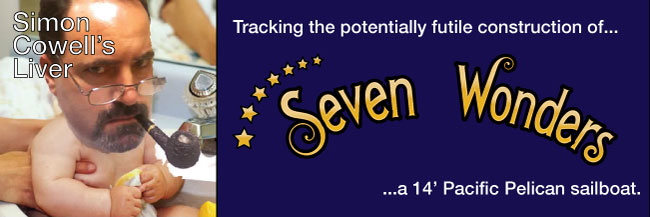According to the Barlow plans. you should be able to run a straight edge, positioned thwart-ship, from stem to stern, and make fair contact with both chines and the keelson the entire way. I had a few spots that were rather off, and needed some correction.
So, I made some tweaks to the location of the chine notches (the things that hold them in position). One of them in particular needed to be raised almost 3/4". I guess that flare form got knocked out of level somewhere along the way. No worries. That's one of the cool things about building the jig this way...you can adjust it easily later.
There were a couple of spots where I needed to raise up the keelson. I found that wedging some roof flashing between the keelson and the strongback did the trick:
And there were some spots where the keelson needed to be brought down a bit. I used Spanish windlasses for that, and found that I could attach one to either side of the keelson to adjust it for level as well.
After quite a bit of that sort of thing, it is in pretty good shape. You can't tell from this shot (compared to earlier shots from a similar angle), but this thing is about dead-nuts perfect right now:
There are still a few points along the chines, particularly toward the bow, where the bevel needs to be adjusted. I put together this fairing board to handle that:
Once the epoxy sets tomorrow, I'll glue some sandpaper to the bottom and have at it. I'm also hoping that that board will help me do a neat job of fairing the hull. I'm planning on painting it dark blue with a gloss finish, which I expect is going to be pretty unforgiving of anything less than perfect smoothness.
I also decided that the Spanish windlasses that I used to pull the chines down at the stern were no longer necessary now that the joints are cured. I went ahead and pulled them off, which let me get the belt sander onto the chine blocks and clean them up a bit from the gluing. They came out pretty nice:
Last task for the day was to make my scarfing jig. I got it put together, but I think I'm going to do it over. I calculated my required angle at 8.5 degrees, but I don't think that is sharp enough. I am going to re-do it at 11 or 12 degrees, which I think will give a cleaner result.
If I can get that done tomorrow night, along with the final sanding/fairing of the chines, I should be scarfing the sides on Tuesday and installing them on Wednesday.























































